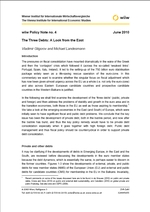The Three Debts: A Look from the East
Vladimir Gligorov and Michael Landesmann
wiiw Policy Note/Policy Report No. 4, June 2010
12 pages including 6 figures
In the following we shall first examine the development of the 'three debts' (public, private and foreign) and then address the problems of stability and growth in the euro area and in the transition economies, both those in the EU as well as those aspiring to membership. We take a look at the emerging economies in the East (and South) of Europe, which were initially seen to have significant fiscal and public debt problems. We conclude that the key issue has been the development of private debt, both in the bubble period, and now after the bubble has burst, and thus the key policy remedy would have to be private debt consolidation especially when it goes together with high foreign debt. Public debt management and thus fiscal policy should be countercyclical in order to support private debt consolidation.
Keywords: eurozone problems, public debt, foreign debt, private debt, macroeconomic imbalances, eastern europe, economic crisis
JEL classification: E60, E61, E62, E63, F32, F34 , G15, H63, H87
Countries covered: Central, East and Southeast Europe, European Union
Research Areas: Macroeconomic Analysis and Policy
